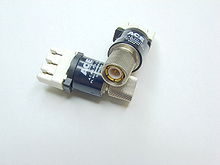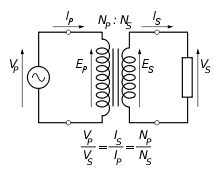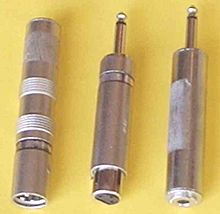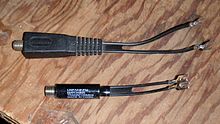- Balun
-
 Pair of AC&E 120 Ohm twisted pair (Krone IDC) to 75 Ohm coaxial cable balun transformers. Actual length is about 3cm.
Pair of AC&E 120 Ohm twisted pair (Krone IDC) to 75 Ohm coaxial cable balun transformers. Actual length is about 3cm.
A balun (
 /ˈbælʌn/) is a type of electrical transformer that can convert electrical signals that are balanced about ground (differential) to signals that are unbalanced (single-ended), and the reverse. They are also often used to connect lines of differing impedance. The origin of the word balun is bal(ance) + un(balance).
/ˈbælʌn/) is a type of electrical transformer that can convert electrical signals that are balanced about ground (differential) to signals that are unbalanced (single-ended), and the reverse. They are also often used to connect lines of differing impedance. The origin of the word balun is bal(ance) + un(balance).Baluns can take many forms and their presence is not always obvious. They always use electromagnetic coupling for their operation.
Contents
Types of balun
Autotransformer type
In an autotransformer, two coils on a ferrite rod can be used as a balun by winding the individual strands of enameled wire comprising the coil very tightly together. This winding can take one of two forms: either the two windings must be wound such that the two form a single layer where each turn is touching each of the adjacent turns of the other winding; or the two wires are twisted together before being wound into the coil.
The two windings are joined to become a single coil. The end of one of the windings on one side of the coil is connected to the end of the other winding on the other side of the coil. This point then becomes the ground for the unbalanced circuit. One of the remaining ends is connected to the ungrounded side of the unbalanced circuit, and one side of the balanced circuit. Finally, the other side of the balanced circuit is connected to the remaining end.
 Isolated transformer
Isolated transformer
Classical transformer type
Isolated transformers have a real impedance at a resonance frequency where self-inductance and self-capacitance for each individual winding are equal at a given frequency.
Transmission-line transformer type
Baluns can be considered as simple forms of transmission line transformers.
A more complex (and subtle) type results when the transformer type (magnetic coupling) is combined with the transmission line type (electro-magnetic coupling). This is where transmission lines are used as windings, resulting in devices capable of very wideband operation. "Transmission line transformers" commonly use small ferrite cores in toroidal or "binocular" shapes. Something as simple as 10 turns of coaxial cable coiled up on a diameter about the size of a dinner plate makes an extremely effective choke balun for frequencies from about 10 MHz to beyond 30 MHz. The magnetic material may be "air", but it is a transmission line transformer.
 Homemade 1:1 balun using a toroidal core and coaxial cable. This simple RF choke works as a balun by preventing signals passing along the outside of the braid. Such a device can be used to cure television interference by acting as a braid-breaker.
Homemade 1:1 balun using a toroidal core and coaxial cable. This simple RF choke works as a balun by preventing signals passing along the outside of the braid. Such a device can be used to cure television interference by acting as a braid-breaker.
The Guanella transmission line transformer is often combined with a balun to act as an impedance matching transformer. Putting balancing aside a 1:4 transformer of this type consists of a 75 Ohm transmission line divided in parallel into two 150 Ohm cables, which are then combined in series for 300 Ohm. It is implemented as a specific wiring around the ferrite core of the balun.
Delay line type
A large class of baluns uses connected transmission lines of specific lengths, with no obvious "transformer" part. These are usually built for (narrow) frequency ranges where the lengths involved are some multiple of a quarter wavelength of the intended frequency in the transmission line medium. A common application is in making a coaxial connection to a balanced antenna, and designs include many types involving coaxial loops and variously connected "stubs".
One easy way to make a balun is a one-half wavelength (λ/2) length of coaxial cable. The inner core of the cable is linked at each end to one of the balanced connections for a feeder or dipole. One of these terminals should be connected to the inner core of the coaxial feeder. All three braids should be connected together. This then forms a 4:1 balun which works at only one frequency.
Another narrow band design is to use a λ/4 length of metal pipe. The coaxial cable is placed inside the pipe; at one end the braid is wired to the pipe while at the other end no connection is made to the pipe. The balanced end of this balun is at the end where the pipe is wired to the braid. The λ/4 conductor acts as a transformer converting the infinite impedance at the unconnected end into a zero impedance at the end connected to the braid. Hence any current entering the balun through the connection, which goes to the braid at the end with the connection to the pipe, will flow into the pipe. This balun design is not good for low frequencies because of the long length of pipe that will be needed. An easy way to make such a balun is to paint the outside of the coax with conductive paint, then to connect this paint to the braid.
Balun alternatives
An RF choke can be used in place of a balun. If a coil is made using coaxial cable near to the feed point of a balanced antenna then the RF current that flows on the outer surface of the coaxial cable can be attenuated. One way of doing this would be to wrap a lossy material, such as ferrite around the coaxial cable;
Applications
A balun's function is generally to achieve compatibility between systems, and as such, finds extensive application in modern communications, particularly in realising frequency conversion mixers to make cellular phone and data transmission networks possible. They are also used to convert an E1 carrier signal from coaxial cable to UTP CAT-5 cable.
Radio and television
In television, amateur radio, and other antenna installations and connections, baluns convert between 300 ohm ribbon cable or 450 ohm ladder line (balanced) and 75 Ω coaxial cable (unbalanced) or to directly connect a balanced antenna to (unbalanced) coax. To avoid EMC problems it is a good idea to connect a centre fed dipole antenna to coaxial cable via a balun. Match 300 Ω twin-lead cable to 75 Ω coaxial cable.[weasel words]
In electronic communications, baluns convert Twinax cables to Category 5 cables, and back, or they convert between coaxial cable and ladder line.
In measuring the impedance or radiation pattern of a balanced antenna using a coaxial cable, it is important to place a balun between the cable and the antenna feed. Unbalanced currents that may otherwise flow on the cable will make the measured antenna impedance sensitive to the configuration of the feed cable, and the radiation pattern of small antennas may be distorted by radiation from the cable.
Baluns are present in radars, transmitters, satellites, in every telephone network, and probably in most wireless network modem/routers used in homes. It can be combined with transimpedance amplifiers to compose high-voltage amplifiers out of low-voltage components.
Video
Baseband video uses frequencies up to several megahertz. A balun can be used to couple video signals to twisted-pair cables instead of using coaxial cable. Many security cameras now have both a balanced unshielded twisted pair (UTP) output and an unbalanced coaxial one via an internal balun. A balun is also used on the video recorder end to convert back from the 100-ohm balanced to 75-ohm unbalanced. A balun of this type has a BNC connector with two screw terminals. VGA/DVI baluns are baluns with electronic circuitry used to connect VGA/DVI sources (laptop, DVD, etc.) to VGA/DVI display devices over long runs of CAT-5/CAT-6 cable. Runs over 130 m (400 ft) may lose quality due to attenuation and variations in the arrival time of each signal. A skew control and special low skew or skew free cable is used for runs over 130 m (400 ft).[citation needed]
Audio
 Three audio baluns (transformers).
Three audio baluns (transformers).
In audio applications, baluns convert between high impedance (see Nominal impedance) unbalanced and low impedance balanced lines.
Except for the connections, the three devices in the image are electrically identical, but only the leftmost two can be used as baluns. The device on the left would normally be used to connect a high impedance source, such as a guitar, into a balanced microphone input, serving as a passive DI unit. The one in the centre is for connecting a low impedance balanced source, such as a microphone, into a guitar amplifier. The one at the right is not a balun, as it provides only impedance matching.
In power line communications, baluns are used in coupling signals onto a power line.
See also
- Electromagnetic interference
- Ferrite (magnet)
- Ferrite bead
- Magnetic core
- Toroidal inductors and transformers
- Unintentional radiator
References
- Building and Using Baluns and Ununs: Practical Designs for the Experimenter, Jerry Sevick (W2FMI), 1994.
- Radio communication handbook, Edition five, Radio Society of Great Britain (RSGB), 1976, pages 12.41 and 13.5
- SWDXER (click ENTER) ¨The SWDXER¨ (was http://dxradio.50webs.com/) - with general SWL information and radio antenna tips (now hosted by http://oh2ffy.50gigs.net/).
- Coaxial Balun Coaxial Balun sample by yagi-uda.com
Categories:- Transformers (electrical)
- Electromagnetic coils
- Radio electronics
Wikimedia Foundation. 2010.



